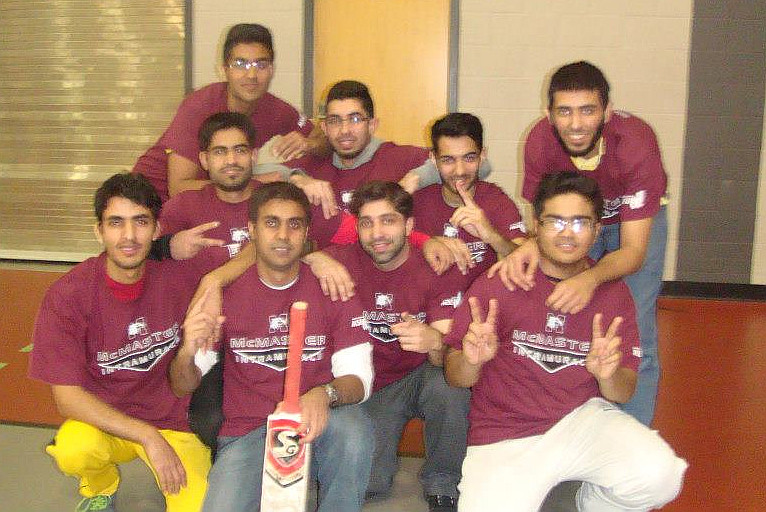Programs & Services: Intramural Sports
Intramural Cricket
Sport leagues and tournaments for the entire McMaster community, beginner to advanced, individual or team: We want to play with you!
 Need an accommodation? Submit Accommodation Request
Need an accommodation? Submit Accommodation Request
For more information: intramurals@mcmaster.ca

Activities include: Cricket
Winter Leagues
- When are leagues and tournaments in this sport offered? What PlayStyles are available?
Check the Sport Calendar on the 'SPORTS' tab of our Intramural Sports page.
- Who can play Intramural Sports at McMaster? How do I register?
Check the 'REGISTER' tab of our Intramural Sports page.
- Accessible
- Registration Required
Facilities
Open Indoor Cricket Rules
Game play is governed by the 'Laws of Cricket,' as developed by the Marylebone Cricket Club, with the following additions:
A) PLAYERS:
1. Maximum of 8 players per team on the playing field at a time.
B) GAME SETUP:
1. Playing Field: The pitch will be setup within the gymnasium with wickets positioned towards the 'back wall' and the 'playing area' in front.
a) A ball is considered in play as long as it remains within the defined playing area. The playing area is constituted to be all space inside the open side of the solid red line. The ball is out of play if any part of it touches the red line.
2. Game Length: Games are 7 overs long with 45 minute time limit.
3. Equipment - Ball: A "tape-ball" will be used (modified tennis ball).
C) GAME PLAY:
1. Batting: 2 batters at all times - one at the batting end, the other at the bowling end.
a) Upper-Boundary – Automatic Out: Any batted ball that leaves the Sport Hall (entering the track), hits the metal railings, or that strikes the ceiling, lights, or above the white-line is an automatic out. Any disregard for the well-being of others, or equipment, will result in removal from play at the official's discretion.
2. Fielding: Aside from the bowler and wicket-keeper, fielders position themselves as they desire.
3. Scoring: Teams score runs when batters reach the opposite crease safely.
a) Batter: A run is completed when a batter hits the ball and then runs to the other end of the cricket pitch, getting past the crease.
b) Non-striking Batter: Must run opposite the ‘striking batter’.
c) Getting Out: The batters can run as many times as they like, but if a fielder hits their stump while they are outside the crease, the batter is out.
d) Walls: One run will be awarded if a batted ball hits the side walls or the wall behind the wicket-keeper. A run will also be awarded if the ball hits the back wall on a wide or legitimate delivery. The runs are awarded based on the first wall the ball comes into contact with.
4. Scoring by Boundaries: Runs can be scored by hitting boundaries.
a) Bounce-to-Front Wall: Score 4 runs.
b) Direct-to-Front Wall: Score 6 runs.
5. Bowling/Pitching: A bowler has to bowl 6 bowls in an ‘over’. Maximum 2 overs per bowler per game.
a. If a bowler fails to deliver a hittable ball, as below, runs will be scored:
i. No balls: When the bowler oversteps the crease, bowls in a dangerous manner or incorrectly, or if the ball rises above the batter’s head -- score one run, and re-bowl the pitch.
ii. A wide: When the ball goes outside the line indicated next to the wickets -- score one run, and re-bowl the pitch.
iii. A leg bye: When the ball hits the batter without contacting their bat, the batter may NOT score by running. If the ball proceeds to hit the wall on a leg bye, runs for the wall contact are not awarded.
iv. A bye: When the batter runs without the ball coming into contact with their body or bat, they may score by running. Runs for the the ball making contact with the wall are rewarded.
6. Fielding for Outs:
a) Catching the Batter Out: When a fielder catches a ball off the batter’s bat before it has contacted the ground – called ‘catching on the full.’
b) Bowling the Batter Out: Bowling the ball and striking the batter’s stumps or bails.
c) Stumping the Batter: When the wicket-keeper fields a pitch and hits the stumps catching a batter out of their crease.
d) Run Out: When a fielder hits the batter/runner’s stumps while they are outside of the wicket crease.
e) Hit Wicket: When the batter hits their own stumps while trying to hit the ball.
7. Tie-Breaking Procedure: There are no ties! In the event of a tie at the end of regulation, a bowl-out will take place.
a) A bowl-out is similar to a penalty shootout in soccer: Each team will be given five chances to bowl to open stumps and the team hitting the stumps the most times will advance.
b) Each bowler can only bowl once.
c) If still tied after five bowlers each, a sudden-death bowl out begins with each team taking one bowl until one hits and the other misses. The sudden-death bowler must be one of the initial five bowlers.
d) Both teams will be awarded one point in the standings for the tie - the winner of the bowl-out is awarded the additional point (total 2) for the win.
